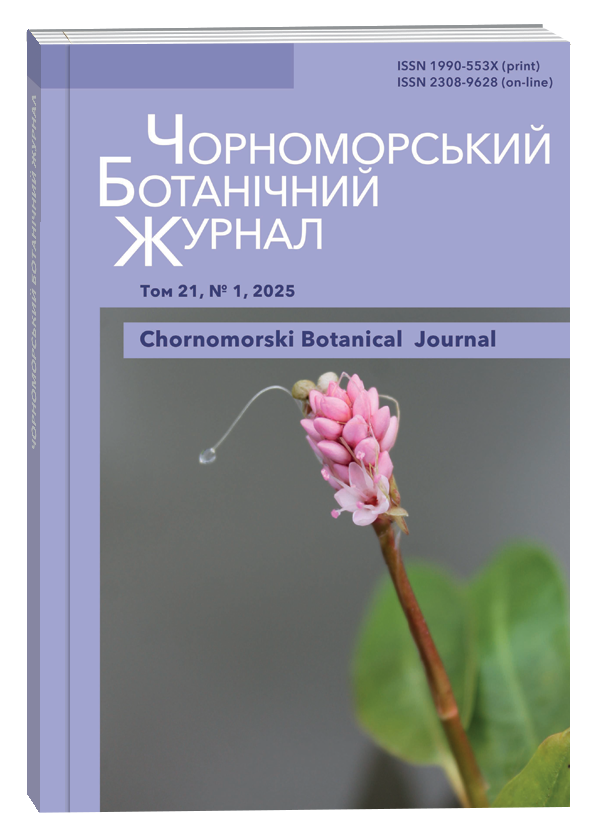Distribution of Laboulbeniomycetes (Ascomycota) in habitats of the steppe zone of Ukraine
DOI:
https://doi.org/10.32999/ksu1990-553X/2025-21-1-4Keywords:
biodiversity, fungi, mycobiota, substrate specificity, Coleoptera, Staphylinidae, Carabidae, grasslands, dry grasslands, grass steppae, temperate steppae, steppe, wetlandsAbstract
Question: How many species of Laboulbeniiomycetes occur in the steppe zone of Ukraine? How these fungi distributed among habitat types? Location: steppe zone Ukraine. Materials and methods: field research, mycotheca (KHER-L), microscope technique, identification of habitat types based on their description in the National Habitat Calaloque of Ukraine. Nomenclature: https://www.indexfungorum.org/, National Habitat Catalogue of Ukraine (Kuzemko et al. 2018). Results: In the steppe zone of Ukraine, 47 species of fungi of the class Laboulbeniomycetes (Ascomycota) were found on 62 species of insects belonging to 44 genera, 8 families and 3 orders. The leading genera by the number of species are Laboulbenia – 26 species (55.3 %) and Rhachomyces – 3 species (6.4 %). The genera Cantharomyces, Distolomyces and Herpomyces are represented by two species each (4.2 %). The genera Amorphomyces, Corethromyces, Dioicomyces, Eucantharomyces, Hesperomyces, Mimeomyces, Misgomyces, Monoicomyces, Peyritschiella, Rhadinomyces, Sphaleromyces and Zeugandromyces are represented by one species each (2.1 %). The largest number of fungal species is associated with insects that prefer habitats with constantly moist soils, especially riverine habitats, floodplain willow-poplar forests, and wet grasslands. Under such conditions, a significant diversity of saprophytes and phytophagous species is observed, which in turn serve as a food base for small predatory insects, many of which are hosts of Labulbeniales fungi. Increased air and soil humidity, more abundant and frequent precipitation in the form of fog also contribute to the growth and development of Labulbeniales fungi. In grassland areas with dry soils, in habitats with extremely high soil salinity, a small number of Labulbeniales species have been found. Host insects that prefer drier steppe areas are more often attacked by these fungi where the steppe is close to a water body or in the lower floodplain of this reservoir.
References
De Kesel, A., Gerstmans, C. & Haelewaters, D. (2020). Catalogue of the Laboulbeniomycetes of Belgium. Sterbeeckia 36: 3–143. http://dx.doi.org/10.6084/m9.figshare.11954811
De Kesel, A., Gerstmans, C., & Haelewaters, D. (2022). Rare Laboulbeniales from Belgium. Sterbeeckia 37: 27–38.
Gerstmans, C. & De Kesel, A. (2023). Laboulbeniales new for Belgium (1). Sterbeeckia 38: 3–8.
Kuzemko, A.A., Didukh, Ya.P., Onyschenko, V.A. & Sheffer, Ya. (eds). (2018). National habitat catalogue of Ukraine. Reds. A.A. Kyiv, FOP Klymenko Yu.Ya., 442 p. (in Ukrainian)
Kuzemko, A.A. (ed.) (2022). Atlas of the grassland of Ukraine. Chernivtsi: Druk Art, 244 p.
Löbl, I. & Löbl, D. (2017). (eds.). Catalogue of Palearctic Coleoptera. Vol. 1. Archostemata – Myxophaga – Adephaga. Brill, Leiden, Boston.
Löbl, J. & Smetana, A. (2004) (eds.). Catalogue of Palearctic Coleoptera. Vol. 2, Hydrophiloidea – Histeroidea – Staphylinoidea. Apollo Books, Stenstrup.
Majewski, T. (2003). Distribution and ecology of Laboulbeniales (Fungi, Ascomycetes) in the Białowieża Forest and its western foreland. Białowieska Stacja Geobotaniczna Uniwersytetu Warszawskiego, Warszawa, 2003.
Mishustin, R., Darmostuk, V. & Khodosovtsev, A. (2022). First overview of Laboulbeniomycetes (Ascomycota) from Ukraine with new records for the country. Czech Mycology 74 (2): 123–139. https://doi.org/10.33585/cmy.74202
Mishustin, R. & Khodosovtsev, A. (2022). New records of Laboulbeniales (Ascomycota) from Ukraine. Folia Cryptogamica Estonica 59: 53–60. https://doi.org/10.12697/fce.2022.59.09
Mishustin, R. & Khodosovtsev, A. (2023). More Laboulbeniales (Ascomycota) from Ukraine. Czech Mycology 75 (1): 1–14. https://doi.org/10.33585/cmy.75101
Mishustin, R.I., Khodosovtsev, A.Y. & Rossi, W. (2024). New species and new records of Laboulbeniales (Ascomycota) from countries surrounding the Black Sea. Cryptogamie, Mycologie 45 (11): 139–149. https://doi.org/10.5252/cryptogamie-mycologie2024v45a11 https://cryptogamie.com/mycologie/45/11
Rossi, W. & Santamaria, S. (2015). New species of Aporomyces. Turkish Journal of Botany 39 (2): 354–358. https://doi.org/10.3906/bot-1404-104
Santamaria, S. & Pedersen, J. (2021). Laboulbeniomycetes (Fungi, Ascomycota) of Denmark. European Journal of Taxonomy 781: 1–425. https://doi.org/10.5852/ejt.2021.781.1583




